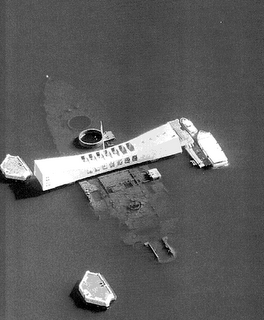
USS Arizona memorial oil slick
The recent Hawaiian earthquake (6.7 Richter scale) and the number of aftershocks underscore that nature, as well as war, can be unpredictable. A catastrophic release of oil would be a dishonor to those who died there.
Most of the USS Arizona, a Pennsylvania class "superdreadnought" battleship, lies submerged in shallow water in Pearl Harbor, Oahu.
The USS Arizona is the watery grave of 1,177 sailors killed by a surprise air attack by Japanese warplanes on Pearl Harbor at 8.06 on Sunday, December 7, 1941, the day that would "live in infamy" and which led the US to declare war on Japan.
A bomb from a Japanese Hiryu Kate detonated the ammunition magazine that caused the massive explosion that destroyed the forward part of the Arizona. Within a year, all but three ships destroyed in the attack were restored for service, but the Arizona remained unsalveagable and in 1962 was designated a national shrine and the men trapped in her hull were considered buried at sea.
A visitor to the memorial can take an audio tour, narrated by the movie sea-salt Ernest Borgnine (of McHales Navy and The Poseidon Adventure fame) and view archival movie footage.
A short boat trip, attended with mainly solemn dignity, takes the visitor to the memorial, an elevated covered platform welded to the ship, to gaze down into the coral-encrusted submerged structure which forms a ghostly background for coloured reef fish, and across the rusting remnants of gun turrets and portions of the structure peeking above the waterline.
Oil leaks from the vessel and forms spectral colours across the water's surface and moving shapes in the oil encourage contemplation and speculation as many shapes take on forms dictated by the observer's state of mind.
A local mythology claims the oil is the "tears of the dead" and women toss orchids from their leis and others shed a tear.
More sinister however, is the fact that the Arizona still holds 500,000 gallons (2,200 tons) of fuel oil within its corroding hull. Although marine surveyors have mapped the hull, high-tech computer modelling systems such as Finite Element Analysis predict the sequence of the ship's deterioration and National Parks Service archaelogists employ ultrasound to measure the thickness of the hull and to analyse load and stress on the structure, it seems a catastrophic release of oil is inevitable.
The recent Hawaiian earthquake (6.7 Richter scale) and the number of aftershocks underscore that nature, as well as war, can be unpredictable. A catastrophic release of oil because of unpreparedness would be a dishonor to those that died there.


<< Home